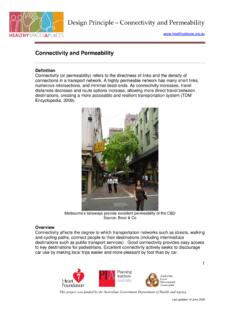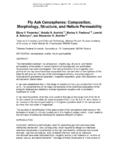Transcription of Moisture permeability through multilayered barrier films ...
1 Moisture permeability through multilayered barrier films as Applied to Flexible OLED Display J. Greener,* K. C. Ng, K. M. Vaeth, T. M. Smith Eastman Kodak Company, Rochester, New York 14650-2158. Received 27 February 2007; accepted 29 March 2007. DOI Published online 28 August 2007 in Wiley InterScience ( ). ABSTRACT: Strict protection of organic light-emitting barrier lms. The modeling results identify two regimes, diodes (OLEDs) and other optoelectronic materials from corresponding to two distinct permeation mechanisms, and direct contact with ambient Moisture and oxygen is one of provide scaling relationships and general design criteria for the major challenges in the development of exible OLED multilayered barrier coatings. The results suggest that the displays and other exible electronic devices. This problem most signi cant gain in barrier performance can be realized is typically addressed by the use of polymeric substrates when the thickness of the organic/adhesive layer(s) in the with multilayered barrier coatings comprising alternating multilayered structure is less than the average pinhole organic/inorganic layers.
2 The multilayered barrier ap- (defect) size in the inorganic barrier layer(s). 2007 Wiley proach is critically examined using a numerical model Periodicals, Inc. J Appl Polym Sci 106: 3534 3542, 2007. based on a defect-dominated diffusion process combined with experiments involving face-to-face lamination of two Key words: OLED; barrier ; lm; WVTR; permeability INTRODUCTION presence of impurities in the vacuum chamber or on the coated substrate (extrinsic defects). Thus, even if One of the major challenges in the development of the substrate is coated with an inorganic barrier exible organic light-emitting diode (OLED) devices layer, the barrier performance of this composite is the need to protect the OLED materials from dam- structure is still expected to fall short for OLED. age by ambient Moisture and oxygen. These devices applications. General approaches to reduce the num- require protective layers and encapsulants with ex- ber and size of pinholes in inorganic layers include tremely low Moisture and oxygen permeabilities.
3 Various modi cations to the vacuum-deposition pro- Moisture permeability of less than 1026 g/m2/day cess while paying close attention to cleanliness. With and oxygen permeability of less than 1023 cc/m2/. these improvements, the permeability can be signi - day are generally cited as the minimum values cantly lowered, but it is still unlikely to meet the required to assure adequate lifetime stability for OLED targets cited earlier. One approach for boost- most OLED Polymeric materials, however, ing the performance of barrier lms was pioneered are inherently porous, having Moisture permeabil- by several companies in the food packaging industry ities typically > 1 g/m2/day, and are therefore not and further developed for OLED applications by a suitable, in themselves, to provide adequate protec- team from Battelle (now licensed and under devel- tion to the OLED materials. One way to lower the opment by Vitex Corp. and known under the trade permeability of the polymeric substrate is to coat it name of Barix1).
4 This approach involves the creation with an essentially impermeable inorganic layer via of a multilayered stack of inorganic layers separated an appropriate vacuum deposition process. Such by thin organic layers (typically UV-curable acryl- layers, usually comprising oxides, nitrides, or car- ates), which allegedly creates a so-called tortuous bides, are impermeable to Moisture and oxygen only path'' for the diffusing species, thereby lowering the if the layer is free of defects. However, defects overall permeability of the 4 With this general ( pinholes'') are inherently present in vacuum-de- approach Vitex and others claim water vapor trans- posited layers because of imperfections in the depo- mission rates (WVTRs) approaching the 1026 g/m2/. sition process (intrinsic defects) or as a result of the day target. However, this method is quite costly and not suf ciently robust. Particularly problematic with Correspondence to: J.
5 Greener this approach are the issues involving acrylate depo- *Present address: Rohm and Haas Electronic Materials, sition and curing, including control of lm thickness, Rochester, New York 14650. particulate formation in the deposition chamber, and Journal of Applied Polymer Science, Vol. 106, 3534 3542 (2007) health and safety concerns with the acrylate formula- V. C 2007 Wiley Periodicals, Inc. tion. A very similar structure can be fabricated by Moisture permeability through multilayered barrier films 3535. high Ld (or low pinhole density) values. Such layers can be produced by utilizing a deposition process that minimizes intrinsic defects and/or by operating in a clean room'' environment to minimize extrinsic defects. Gas transport through any adjacent organic layer ( , a polymeric substrate or a coated/lami- nated layer) follows a given diffusive law. In the present analysis, we assume the diffusion processes in all organic layers to be Fickian.
6 Figure 1 Schematic representation of a barrier lm. In the rst part of the analysis, we consider a lam- inate structure of the type shown in Figure 2. In this structure, the two barrier lms ( barrier lm 5 poly- laminating two barrier lms together to create a meric substrate coated with an inorganic barrier multilayered structure similar to the Barix1 structure layer) are laminated face-to-face, , with the two but potentially at a signi cantly lower cost. barrier layers joined together by an adhesive layer, To assess the feasibility and potential of the lami- as shown. The thickness of the adhesive layer, La, nation approach and, more broadly, the multilayered and the diffusion coef cient of the adhesive material, approach, for attaining the challenging barrier Da, are parameters associated with the lamination requirements for exible OLED display, we devel- process and the adhesive formulation. In the scheme oped a numerical model, based on a defect-domi- in Figure 2, two adjacent pinholes on both sides of nated diffusion process, to evaluate the Moisture the adhesive layer are shown to be a distance L0d permeability through various types of organic inor- apart.
7 This length scale represents the average mis- ganic layered stacks. The model is delineated in the alignment ( misregistration'') of two defects in two Diffusion Model'' Section, and experiments de- adjacent barrier layers produced by the lamination signed to test the computational results are de- step, and it is generally not the same as the Ld para- scribed in the Experimental'' Section. The modeling meter de ned earlier. But these two length scales are and experimental results are presented in the closely correlated, so we use the same notation for Results and Discussion'' Section, and their implica- both parameters, , Ld L0d. The ux [ permeability , tions for future opportunities with this approach are p, or WVTR, see eq. (7) below] across the laminate discussed in the Summary'' Section. structure can be obtained by solving the three- dimensional (3D) diffusion equation with the corre- sponding boundary conditions, DIFFUSION MODEL.
8 8 9 8 9 8 9. qu q qu q > qu> q qu The defect-dominated diffusion modeling framework >:D > ; > :D > ; > :D > ; (1). for describing Moisture and gas transport through qt qx qx qy qy qz qz inorganic barrier layers was rst proposed by Prins and Simply stated, this approach assumes u ub1 at z 0. that water or gas molecules can traverse within an (2). u ut1 at z L. inorganic layer only through existing defects or pin- holes. Thus, for the purposes of this analysis, this qu layer is taken to be in nitesimally thin and is charac- 0 at the barrier surface (3). qn terized by a nominal defect (pinhole) size, Lh, and an average pinhole density Nd ( pinholes/unit area), which is directly related to the average distance between pinholes, Ld. For simplicity, the defects are represented by virtual holes'' with an average size (diameter), Lh, which corresponds to the rate of Moisture transport through the defect; the larger the value of Lh, the higher the permeation rate through the layer.
9 A similar approach was applied in several studies4 9 to tackle the problem of Moisture trans- port through various barrier layer structures. A sche- matic representation of the porous barrier layer is shown in Figure 1. Lh and Ld are assumed to be known parameters that de ne the quality of a given barrier layer. Good'' barrier layers, , layers with Figure 2 Geometry of a laminate structure [see eqs. (1) . low Moisture or gas permeability , have small Lh and (3) for de nitions]. Journal of Applied Polymer Science DOI 3536 GREENER ET AL. where u is the mass Moisture concentration, D is the differential equation (ODE) solver to solve the corre- diffusion coef cient that can vary from layer to sponding set of ODE's. As we are interested in the layer, ub1 and u1 t are the concentrations at the bot- steady-state solution (du/dt 5 0), we can solve the tom and top surfaces, respectively, and n is the out- diffusion equation until the solution becomes con- ward normal to the lm surface.
10 Also, as we assume stant over a given time interval or by setting the left- that the barrier lm is semi-in nite along the x- and hand side of eq. (5) equal to zero. In the latter case, y-axis, edge effects are ignored. At time t 5 0, u 5 0 we obtain a system of linear equations with the throughout the structure except for the top surface unknowns ui,j,k, which can also be solved by a stand- where the Moisture level is speci ed to represent ard linear equation solver. In this scheme, we use a 100% RH. linear equation solver routine to nd the steady-state Because of the irregular geometry of the laminate solution. The sought-after WVTR is de ned as the structure, the corresponding diffusion problem must average ux at z 5 0, , be solved numerically. We use a nite-difference Z Z. scheme with a variable grid to solve this 3D mass trans- 1 qu WVTR D dxdy at z 0 (7). port problem. The computational domain is divided A qz into grid boxes of size (Dx, Dy, Dz), where we denote: where A is the area of the bottom surface.






